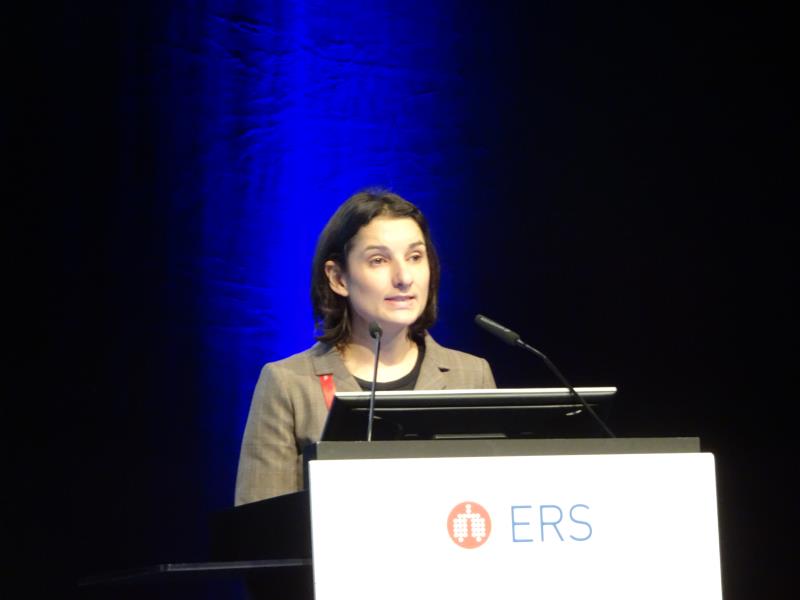 Dr Jo Hardy
Dr Jo HardyAs-needed budesonide–formoterol (ICS* + LABA**) reliever therapy was more effective than maintenance low-dose budesonide plus as-needed terbutaline (maintenance ICS + as-needed SABA***) for preventing severe exacerbations in patients with mild-to-moderate asthma, according to the PRACTICAL# study presented at ERS 2019.
“While maintenance ICS reduces the risk [of exacerbations], in real-world clinical practice adherence is very poor. So, an alternative regimen could be budesonide-formoterol titrated to symptoms,” said lead author Dr Jo Hardy of Medical Research Institute of New Zealand in Wellington, New Zealand.
“The findings also provide further evidence in support of the GINA 2019 update, which recommends against SABA-only treatment of adults and adolescents with asthma, and instead recommends ICS-formoterol reliever therapy for patients with mild asthma,” said Hardy and colleagues.
The risk of severe exacerbations was significantly reduced by 31 percent with budesonide–formoterol used as needed vs budesonide maintenance + as-needed terbutaline (absolute rate per patient per year, 0.119 vs 0.172; relative rate, 0.69; p=0.049). [ERS 2019, abstract OA5332; Lancet 2019;394:919-928]
As-needed budesonide–formoterol also significantly delayed the time to first severe exacerbation compared with budesonide maintenance + as-needed terbutaline (hazard ratio, 0.59; p=0.004).
In context of previous trials
“This was the first independently funded study comparing as-needed ICS–formoterol reliever therapy vs maintenance ICS + SABA reliever therapy in adults with mild-to-moderate asthma in a real-world setting,” highlighted Hardy.
Previously, two regulatory SYGMA-1 and -2 trials showed noninferiority of as-needed budesonide-formoterol vs maintenance budesonide + as-needed SABA for severe exacerbation risk, while the real-world NovelSTART study demonstrated that as-needed budesonide-formoterol significantly reduced the risk of severe exacerbations compared with maintenance budesonide alone or as-needed SABA alone.
“As a result, there are some uncertainties to the relative efficacy of an as-needed budesonide-formoterol regimen compared to budesonide maintenance in real-world clinical practice, and the current study addresses this,” said Hardy.
PRACTICAL is a multicentre, open-label, superiority trial which randomized 885 patients with asthma who met the criteria for GINA step 2 therapy in a 1:1 ratio to receive either budesonide 200 μg–formoterol 6 μg in one single inhaler as needed or maintenance budesonide 200 μg plus as-needed terbutaline 250 μg in different inhalers.
Although the p-value for superiority is close to 0.05, the study — together with the three previous studies — provide more certainty on the relative benefit of as-needed ICS-formoterol in the real world, according to the researchers.
Furthermore, the relative benefit of as-needed budesonide-formoterol over budesonide maintenance + as-needed terbutaline was consistent across all prespecified subgroups, regardless of sex, prior severe exacerbation, baseline eosinophil count, or ICS use at baseline.
There was also no significant difference in asthma symptoms, as measured by ACQ-5 score, between the two groups across all timepoints — which according to Hardy "is important because an inherent concern of the budesonide-formoterol regimen is symptom control.”
When patients are instructed to use their reliever therapy as needed, a worse control of symptoms would be expected than with maintenance ICS. Nonetheless, the comparable ACQ-5 scores between the two arms “is reassuring, suggesting that the inherent concern about symptom control is perhaps not a clinical one,” said Hardy.
“The evidence also supports the inclusion of budesonide–formoterol reliever therapy as an alternative to maintenance low-dose corticosteroids plus SABA reliever in GINA step 2,” noted Hardy and colleagues.
Mild or moderate?
Noting that in Hardy’s presentation and in the study published in Lancet, the findings suggest that the benefit of as-needed budesonide–formoterol extended to patients with mild-to-moderate asthma, session Chair Professor Guy Brusselle from Ghent University in Ghent, Belgium, commented during the discussion session that "this puts patients with moderate asthma (GINA step 3 and 4) at risk of not receiving any maintenance therapy although this is recommended for this population in the GINA guidelines.”
“I think you can say that there were patients with moderate asthma in the study, given that at baseline patients could be taking up to 800 µg per day of budesonide equivalent dose who were eligible for this study,” responded Hardy.
When asked about the proportion of patients who had moderate asthma in the study, Hardy said “70 percent of the patients in the study were using ICS at baseline. I don’t have the numbers of participants who were taking moderate doses as it was not systematically recorded in the study.”
“Now we have got four beautiful studies, do you think we need to do any more [studies] or do you think we have enough data now to suggest that at GINA [step] 1, we should be using anti-inflammatory reliever therapy?” asked session co-Chair Professor Andrew Menzies-Gow from the Royal Brompton Hospital in London, UK.
Hardy agreed, saying that currently there is adequate evidence that ICS-LABA is the preferred option for GINA step 1.
Remaining questions
“Although the regimen is promising, some questions remain. Identification of type 2 inflammation is crucial in severe asthma, but its role in mild asthma remains unclear,” commented Drs Marc Gauthier and Sally Wenzel from the University of Pittsburgh Graduate School of Public Health in Pittsburgh, Pennsylvania, US, in a linked commentary. [Lancet 2019;394:897-898]
Currently, there are also no known biomarkers to select patients with mild asthma who are likely to benefit from the therapy.
“It also remains to be determined how mild is mild enough for as-needed ICS–β-agonist therapy … How mild or how often should symptoms or exacerbations occur to warrant ICS–β-agonist therapy?” wrote Gauthier and Wenzel.
“A better understanding of the biology behind frequently exacerbating asthma (including biomarkers) might help to identify which patients are most likely to benefit or which warrant maintenance therapy,” they suggested.